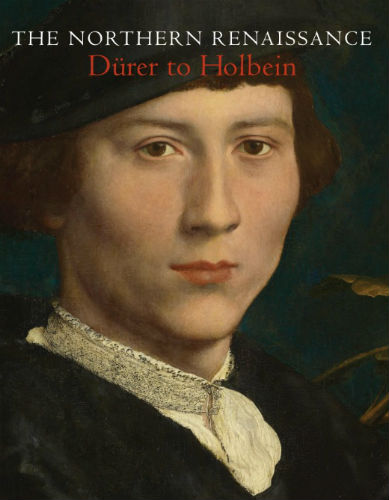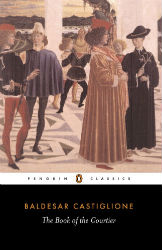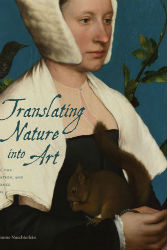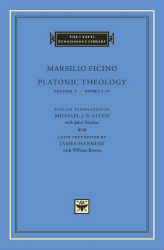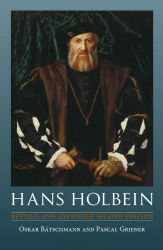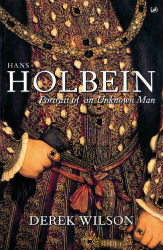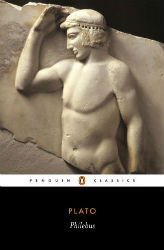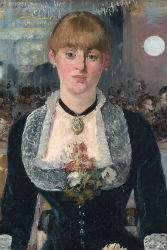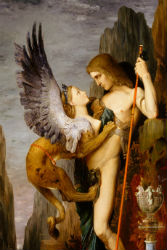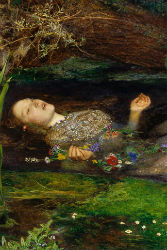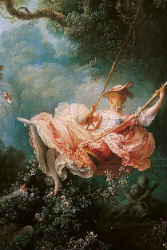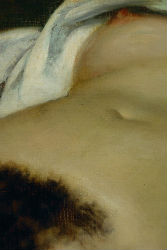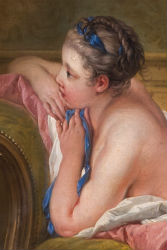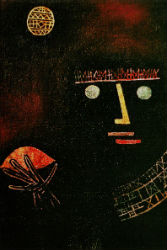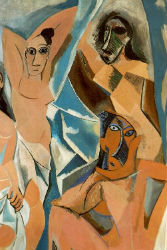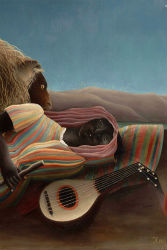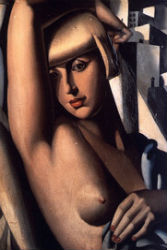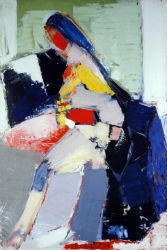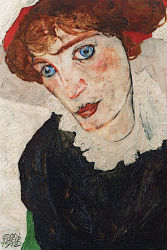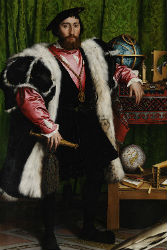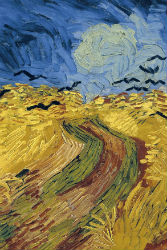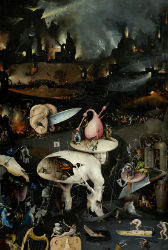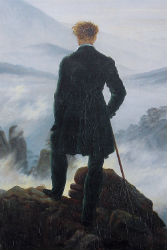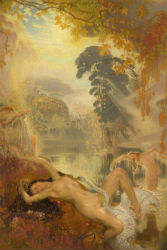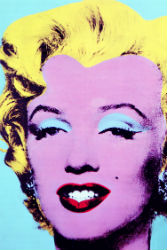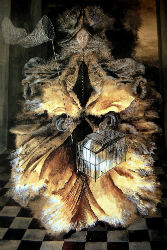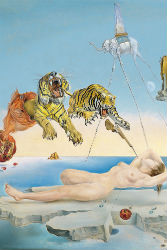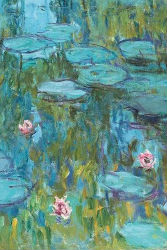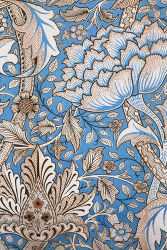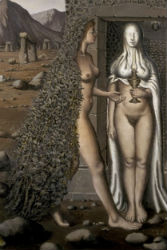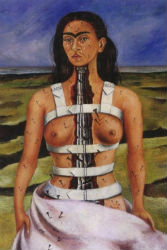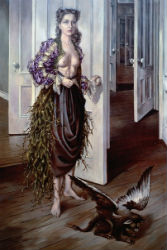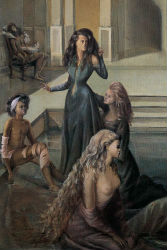Hans Holbein the Younger
The Ambassadors
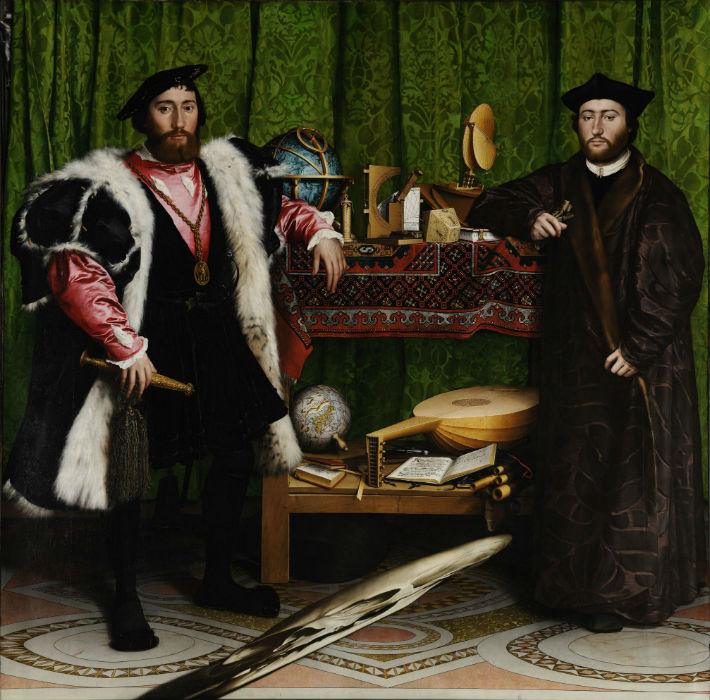
Hans Holbein the Younger, The Ambassadors, 1533
FROM ‘MARA, MARIETTA’
Part One Chapter 4
Hello Sprague, I send you these Ambassadors with my warmest greetings from London. Looking at this magnificent painting in the National Gallery, I thought of your notion of fragility, and somehow connected it with the photograph you gave me. Thank you! It was a lovely surprise. Work going well. Back on Friday. Marietta … Sunday morning I slipped fifty francs into the hand of your concierge and got her to promise she’d get my package to you: I was happy to learn, from your Ambassadors, that she did.
The Ambassadors: I did notice, in your postcard, how the oblique disrupts the aplomb. Yes, it did not escape me—that curve of cranium, those orbits of eyes. Astrological instruments, globes terrestrial and celestial; a lute, an open book, a folding set square—they did not distract me from the death’s head. Nor could the fine clothes—the black velvet, the pink satin, the purplish-brown brocade—divert me from the memento mori. But what did I care? I knew before long we’d be making love. Now tell me: Why did you leave it to Mara to teach me that as love is traced by death, it traces the space between identities? That my desire…
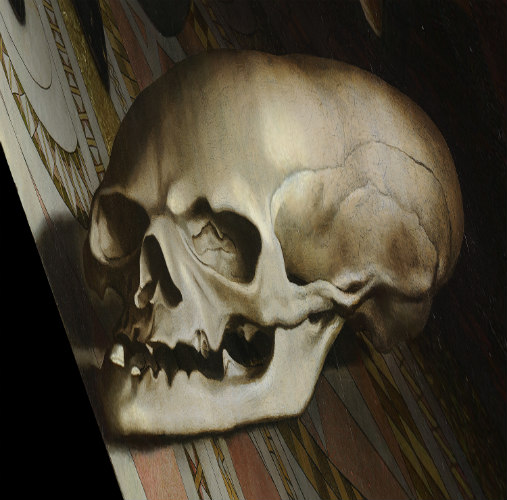
The anamorphic skull as restored in 1998
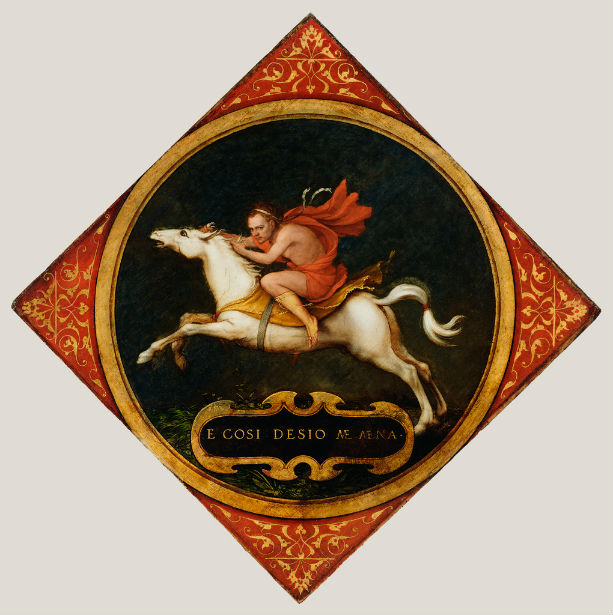
Hans Holbein the Younger, An Allegory of Passion, c.1534
‘And so desire carries me along’ – Petrarch, Canzoniere, 1342
That my desire to know my identity coincides with my desire to know and love you? And for this, you would have to— No, I’m getting ahead of myself. Let’s close this interlude and pick up our story with your return from London. Oh happy days!
JOHN NORTH ON HANS HOLBEIN THE YOUNGER
From John North, The Ambassadors’ Secret: Holbein and the World of the Renaissance (London: Phoenix Books, 2004)
This excerpt is an abbreviated version of Chapter 17, ‘Apelles and Clio’.
Duke: One face, one voice, one habit and two persons; a natural perspective, that is and is not.
Shakespeare, Twelfth Night, Act V, Scene 1
To suggest that there was more than one person behind the planning of The Ambassadors is not to detract in any way from Holbein’s final responsibility for it, or for the genius that lies behind its execution. He was a product of his age, conforming to the often strange rules of his time, but there is an honesty and a vitality in the painting that comes from him alone, and to most of those who marvel at his work those qualities have an infinitely stronger appeal than his concealed designs are ever likely to have. His paintings, however, were the product of hand and eye and mind. To call The Ambassadors a ‘painting’ tends to suppress that idea, as though the paint was what mattered most. It is rather as though one were to describe all works of literature as ‘inkings’. The double portrait offers proof, if any were needed, that unequalled though he was as a painter of what he saw, Holbein was not above collaborating with others in affairs of the mind. It is proof that he was never more successful than when he did so.
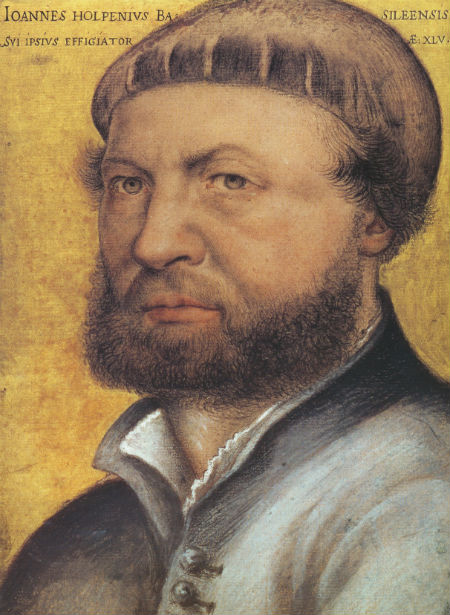
Hans Holbein the Younger, Self Portrait, 1542-43
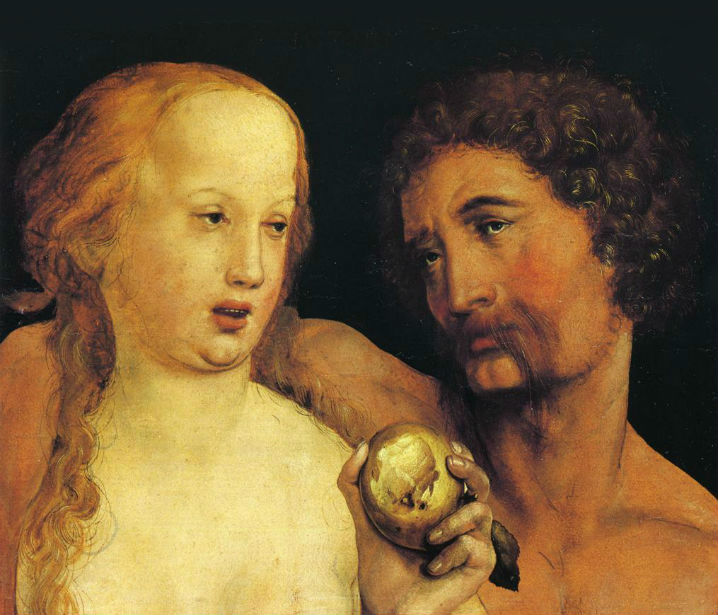
Hans Holbein the Younger, Adam and Eve, c. 1517
History is now wary of the notion of the Renaissance mind, since it seems to carry with it the notion of a dominant intellectual and creative pattern that is in truth very hard to find in sixteenth-century life as a whole, whether in London or in Florence. There is certainly something odd about applying a nineteenth-century French label to an earlier Italian cultural movement, and then adapting it to an entire European historical period, during which a small minority—some of the best of them from northern Europe—happened to have fallen in love with classical antiquity. No matter how it is defined, most ‘Renaissance thought’ has medieval streams flowing into it and through it. And no matter how we look at paganising European artists and writers of the period running from the fourteenth century to the sixteenth, we shall find it impossible to conjure away entirely the bedrock of Christianity, which was in no sense new, Protestantism notwithstanding. The Ambassadors tells us as much.
Despite such qualifications, there was much that was new and exciting afoot when Holbein was at work, and of which he was certainly conscious. Religious art was suffering a decline, given the spiritual uncertainties associated with the Reformation. It was a diagnosis offered by several critics in the nineteenth century that art as a whole suffered in Holbein’s time, with the decline of religious inspiration. Holbein, however, was not one to allow the grass to grow under his feet. He did not need to be either a religious reformer or one of a select group of scholarly initiates to feel that he lived in an age that owed much of its vigour to the opportunities it offered to individuals of merit. It was an age that positively encouraged self-definition. He must have felt it on his own behalf and on behalf of those he served. His portraiture served the new cult of the ‘dignity and excellence of man’, to use a phrase common among the humanists.
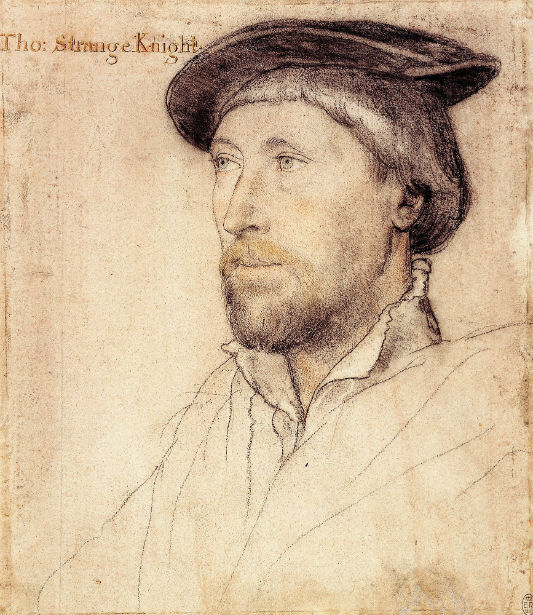
Hans Holbein, Sir Thomas Lestrange, c.1536
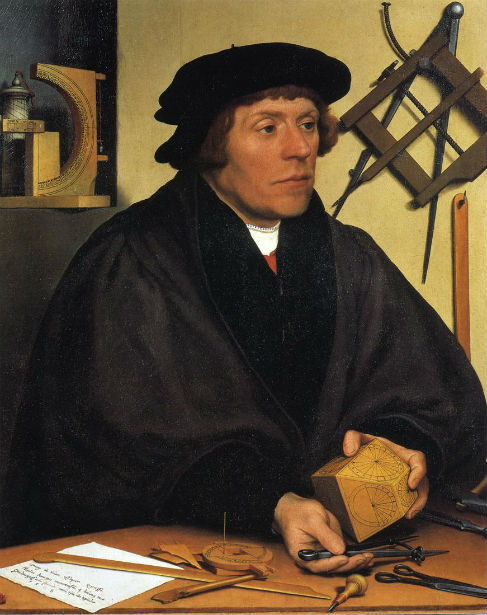
Hans Holbein the Younger, Portrait of Nikolaus Kratzer, c.1528
Young and inexperienced as they are, the bailly of Troyes and the bishop of Lavaur are shown to us as men of rank and moral stature, men who lived in a three-dimensional world, with feet on the ground but with thoughts in tune with the divine. Or that, at least, was the theory. In practice, as Holbein through his art shows us equally plainly, they were men of their time, taking delight in some of the great intellectual diversions of the time, which could carry their thoughts away from the uncertainties of the moment. New worlds were meeting with old, new forms of scientific and human understanding were being mingled with old—gematria with theology, alchemy with astrology, perspective with the techniques of astronomical instrument making, anamorphosis with ‘true’ perspective, and so forth. Intriguing and even awe-inspiring new ways of encoding familiar truths were being canvassed. It does no harm to label them as facets of ‘Renaissance thought’ but, whether or not we do so, Holbein’s portrait of the two French ambassadors seems to give credence to a number of them. These things had the power to startle and excite. No matter that Kratzer was needed, as an expert scriptwriter. Most of us today would be hard pressed to create the things we value most as symbols.
The use of symbols in a painting could make it profoundly fascinating. Patterns show a deeper truth than atoms of paint, however sensitively applied. ‘And though painting bee a diverse matter from carving, yet doe they both arise of one selfe fountaine of a good patterne.’ The opinion was that put forward by one of the leading characters in Castiglione’s Libro del cortegiano (Book of the Courtier) of 1528. It was an opinion voiced as almost a truism, for the simple reason that it had been actively discussed by so many others at the time, and in this instance was very probably derived fairly directly from Leonardo. We should not allow ourselves to be misled by the seemingly endless Renaissance discussion of the importance of ‘pattern’ and ‘design’ into confusing two sorts of pattern. One is calculated to make a painting aesthetically pleasing, the other is a pattern concealed in the placement of the elements, which might have no consequences whatsoever for its beauty. The first was a favourite idea, much discussed, since it had been sanctioned by Plato and Aristotle, not to mention many other classical writers. Stimulated by some of Socrates’ ideas, Plato in his Philebus had proposed a distinctly intellectualist theory of beauty that gave pride of place to formal and structural properties. This linked aesthetics with geometry, often alluded to as the geometry of divine proportion, since the harmonies could be likened to those in God’s first creative act. It is a moot point whether hidden mysteries of form have anything to do with beauty as such. They may stir the emotions in a rather similar way when they are revealed.
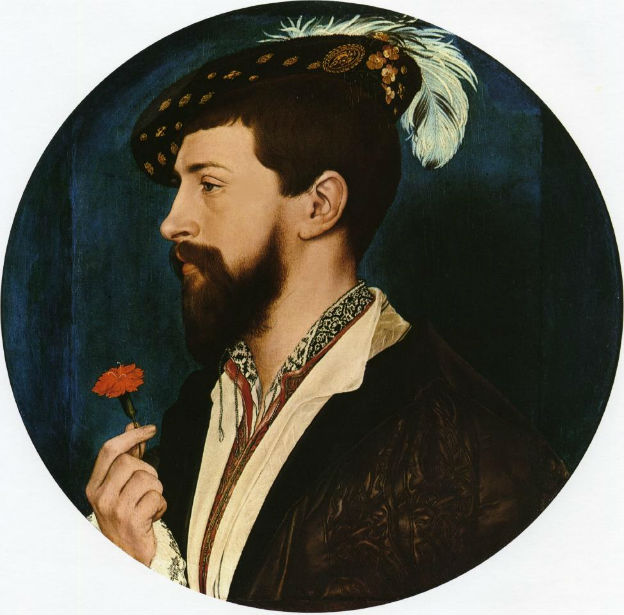
Hans Holbein the Younger, Portrait of Simon George of Quocote, c.1536
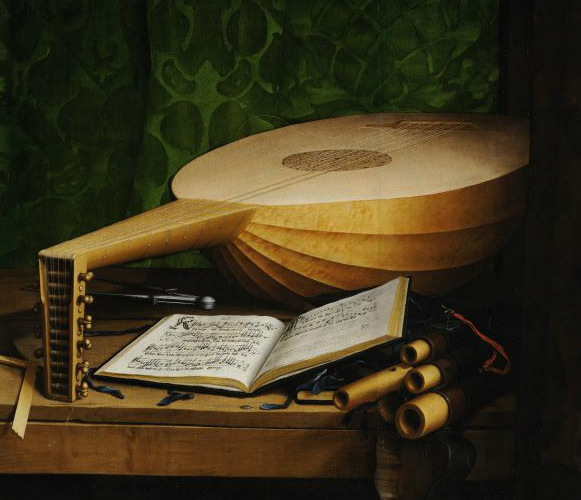
Hans Holbein the Younger, The Ambassadors, 1533 (detail)
There was no shortage of artists in the fifteenth and sixteenth centuries, especially in Italy, whose imaginations were fired by the mystery cults then being uncovered by students of classical learning, especially of Neoplatonism, cults that persuaded artists to create opaque allegories out of pagan deities and myths. The Ambassadors does not fall easily into any of the standard Renaissance categories, because it contains hard calculation. It does, however, have certain elements in common with other products of the time. A scholarly love of classical antiquity took different people in different ways. We need only mention the names of Ficino, Pico, Lefevre d’Etaples, Reuchlin, de Bouelles and Agrippa to see how different they could be. The tensions to which a Christian upbringing subjected them all could have strange effects. There are in The Ambassadors no classical characters, historical or mythological, acting out their parts, for above all else this is a Christian allegory. Holbein did not introduce obviously pagan characters, but still he gives us a taste of a pagan world, for instance in the Christianised Greek cosmology in the pavement, and in the related hexagrams. Humanist scholars with their noses in Neoplatonic texts were able to taste these illicit delights, using the excellent excuse that they were furthering classical learning. In theological debate the problem was acute enough. Ficino and Erasmus were not above elevating Socrates to sainthood. The title of Ficino’s Theologia platonica announces his wish to integrate Platonism with the Christian faith. Some scholars agonised over the fundamental disagreement between pagan Greek and Christian belief, in the end grudgingly recognising that each might supplement the other.
The humanists gave less of their time to natural than to moral philosophy, with its emphasis on personal and social values. This was not the best tool for unveiling cosmic truth, but the natural and exact sciences had too weak a foundation in letters for them to be high on the humanist agenda, and astrology was in a strange category: it did not require to be rediscovered, for it had never lost its academic status or its fascination. Like Hermeticism it was perceived to antedate Christianity and to hail from the East, which gave it a cachet of mystery. It had only weak literary credentials from Greece and Rome, and yet it was established in both cultures. It had fallen foul of some of the great theologians, and yet it had a secure place in artistic life. Writers and artists had learned to weave their materials out of planetary characters, according to rigorously controlled but mainly arbitrary pseudo-astronomical rules. The rules were often respected, it seems, for no better reason than that they were difficult to apply. If, as claimed here, they were applied in the planning of Holbein’s painting, the act would not have earned unqualified approval.
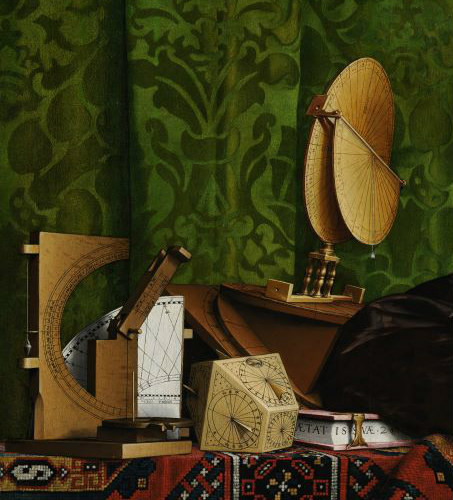
Hans Holbein the Younger, The Ambassadors, 1533 (detail)
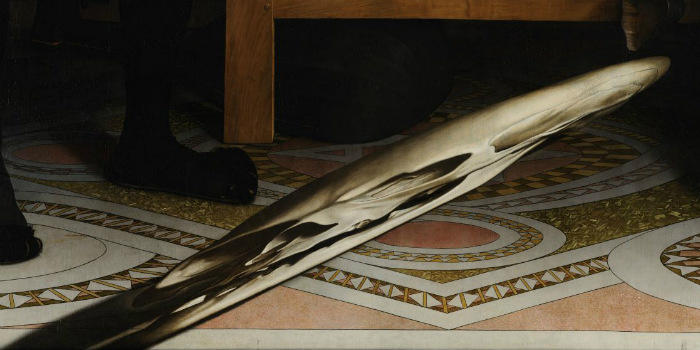
Hans Holbein the Younger, The Ambassadors, 1533 (detail)
No one will deny that The Ambassadors invokes mysteries of some sort, but it is important to distinguish two very different ways in which it does so. The Christian symbolism of a torn curtain, the skull of Adam, the archangel Michael, Sun, Moon and Cross; the Christianised pagan symbolism relating to the Sun and to the creation of the world; the more or less neutral symbolism of the broken lute string: all of these are mysteries on which the painter draws, but they are all distinct from the compositional mysteries. It is in its carefully orchestrated design that the painting is truly exceptional. Those who revile outlandish ideas of the first kind, perhaps horrified at the idea that Holbein could have entertained them, might consider the fact that the process of ‘enchaining the European mind’, to the extent that this is not an exaggeration, was possible because it had a basis in reasoned rather than reasonable argument. These systems of thought were real: their existence can be demonstrated, but whether they are truly to be found in the painting needs supporting argument. Suppose that, one by one, its separate esoteric symbols are dismissed as figments of our imagination. There will still remain the mysteries of design that start with the anamorphosed skull.
In dealing with ‘pagan mysteries’ that were mostly of the first sort, Edgar Wind noted how so many Renaissance humanists picked up the mocking tone of the ancients when they spoke of mysteries. Perhaps there was an element of ‘playing seriously’ in Holbein’s painting too, but if so it is not obvious. What can be said is that it fits well into the category of what Wind describes as ‘conceited art’, which as he says, quoting E.M. Forster, has not met with much sympathy from men of experience. Forster’s point was that if a work of art parades a mystifying element, then to that extent it is not a work of art, ‘not an immortal Muse but a Sphinx who dies as soon as her riddles are answered’. Wind admits that there are symbols which fit this description. ‘They disturb us’, he writes, ‘as long as we do not understand them, and bore us as soon as we do’; but he insists that great symbols are the reverse of the Sphinx, more alive when the riddle is answered. There were at least four men privy to the riddle of The Ambassadors when it was painted, all of whom would have agreed.
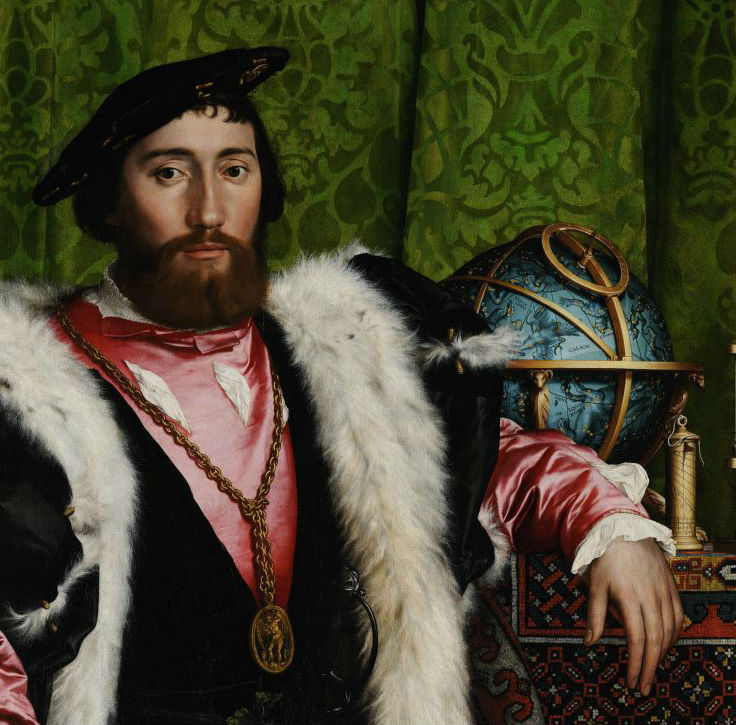
Hans Holbein the Younger, The Ambassadors, 1533 (detail)
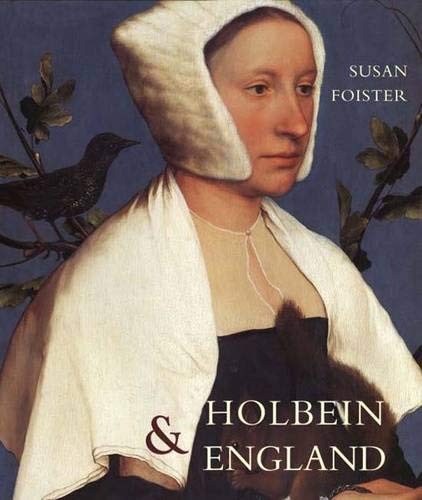
Susan Foister, Holbein and England
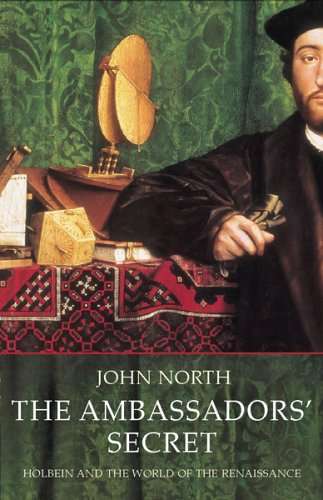
John North, The Ambassadors’ Secret
Ficino, Platonic Theology
Plato, Philebus
